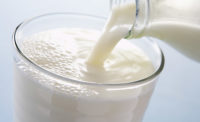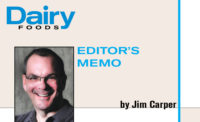Milk producers and processors have seen fluid milk sales slip away over the past several decades. Shifts in the demographic and cultural composition of the United States, as well as factors impacting the overall food marketplace, have contributed to milk’s struggle.
I will recap some of the key barriers to milk consumption and then provide examples of recent success in milk and areas of opportunity.
When you look into the milk category, you see impressive, even enviable, statistics:
- Incredible penetration rate of 98%. There are 113 million milk-drinking households in the United States out of 118 million total.
- Huge fluid milk retail value of $17 billion; in comparison, carbonated soft drinks are $19 billion.
- Each week, there are over 1 billion milk-drinking occasions, or 10% of the beverage market. This amounts to an average of 3.5 occasions per week on a per capita basis, or nearly seven occasions per user.
- There’s good emotional energy around milk. It is wrapped in nostalgia, as most people view it as a classic. It’s seen as a smart and healthy choice. It’s considered wholesome. It’s family and it’s trustworthy.
Yet, despite the magnitude of individuals and households involved in our category, milk has lost “fans.”
The long-term picture is one of a slippery slope. Each year, fluid milk consumption drops a little lower. According to the U.S. Department of Agriculture, Washington, D.C., in 2012 there were 19.6 gallons available for consumers to consume on a per capita basis. In comparison, in 1970, there were 30.9 gallons.
Total sales of fluid milk moving through all channels as measured by the USDA show a downward slide that has accelerated in 2013-14, with 2014 year-to-date volume through July down 2.6% compared to the same period in 2013.
Retail indicators point to fewer and lighter milk buyers. Milk penetration is high, but deteriorating. In 2010, 97% of households purchased milk annually; in 2014, only 96%. While one point does not appear to be a large drop, it represents a loss of 1.2 million households buying milk. Weekly, the drop is a little more severe, indicating that milk is just a little less of a staple. Whereas in 2008, 71% of people claimed their house “always” had milk in the fridge, this has dropped to 58% in 2014.
Consumption data reinforce this decline. People are gradually dropping out of the milk habit. Analyses of consumption data by the USDA as well as by Kantar Worldpanel, Barcelona, Spain, paint a picture of younger generations’ lower commitment to drinking milk than previous generations. Preschoolers typically are strong milk drinkers. Despite this, USDA data indicate that the percentage of those who do not drink milk on a daily basis rose from 12% to 24% (1977-78 to 2008) and those drinking three or more times a day declined from 31% to 18%. A similar pattern is noted for older kids and adults. People born in the 1990s consume less than those born in the 1970s who consume less than those born in the 1950s.
Demographic and cultural changes are occurring in the United States that have also affected milk. The aging population structure and its increasing diversity has posed challenges for growing milk sales. Milk consumption is highest among children as well as white non-Hispanic segments. Yet by 2020, 33% of the population will be over age 55, and 20% will be Hispanic.
Cultural shifts are occurring in the United States. Moms are now the primary provider in 40% of households with children, and 8% of households are now headed by a single father. A father’s role in the house is also changing. The father is no longer primarily the breadwinner and disciplinarian, but rather also a caregiver and family food shopper in many cases. As the parental role continues to evolve, from a position of “I said so” to one of “so tell me why you don’t agree,” the child’s role in the family changes as well. Children are more empowered today to make decisions, particularly with food. Kids ages 6-9 make 1 in 4 beverage decisions; by age 14, they are making 1 in 2.
Consumers today have more beverage options than ever before. Chicago-based IRI estimates that in 2012, there were over 60,000 beverage product UPCs available to be consumed. Product choices
are abundant, with greater flavor sophistication through exotic fruits, nontraditional and global flavors and even heat and spices in beverages. Categories are becoming blurred and functional ingredients are coming from unexpected beverage categories.
Dairy ingredients have taken advantage of some of these emerging segments with the growth of the breakfast beverage market. Familiar names from the ready-to-eat cereal market are helping to fuel growth as consumers evolve in the way breakfast is consumed.
Gloom among the doom
On the brighter side, milk is growing in nontraditional ways. Beverages that have the ability to offer consumers an enjoyable experience while also delivering on other needs are growing. Lattes, for example, tap into needs traditional milk doesn’t: need to wake up, treat, fun and energy. Similarly, smoothies that often contain dairy ingredients deliver nutrition and a healthier choice while also being considered a treat/fun.
Not all growth is from ingredient usage of dairy in beverages. There is also growth in milk as “milk,” delivering additional value or benefit to the customer. This value-added segment of the milk market, which includes products that can be lactose-free, organic, added protein or omegas, grass-fed, or offer other benefits such as refuel, account for over 7% of the U.S. retail milk market and is growing 5% this year.
There are also additional platforms for milk to launch growth, as innovation can act as a big umbrella. Milk can be re-energized by building the core product to satisfy future generations or leaders of tomorrow where it is slipping. It’s imperative to build a loyal base among youth by developing products/flavors that meet their needs, along with packaging that complements the product. Millennials in particular, while still solidly in the milk category, are more questioning and more experimental outside dairy. Appealing to their sense of adventure and desire for engagement with the products can position milk more solidly in their future. Finally, developing milk products that keep consumers engaged as they age, addressing both physical and mental needs, and offering them in senior-friendly packaging will keep milk relevant to the aging baby boomer group.
The milk industry has great opportunity to develop bigger fans and reap its rewards.









